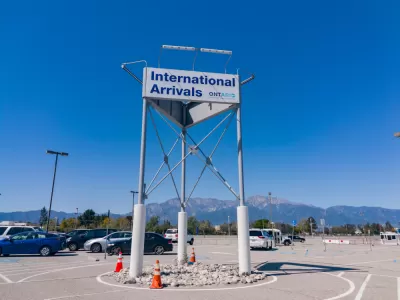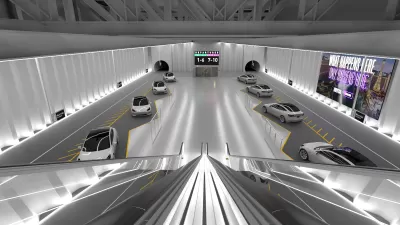The San Bernardino County Transportation Authority decided that Elon Musk's The Boring Comany offers a cheaper, faster alternative to proposals that would build a light rail connection to the Ontario International Airport.

The San Bernardino County Transportation Authority's Board of Directors recently voted to "pursue a proposal from Elon Musk’s The Boring Co. for a high-speed tunnel linking Rancho Cucamonga with Ontario International Airport," reports Steve Scauzillo.
With the vote, the Authority also directed staff to "postpone a $3 million study of other airport-rail connections," according to Scuazillo.
The tunnel idea is seen as a cheaper, faster alternative to above-ground rail projects, including the extension of the electric-powered “L” Line light-rail, formerly the Gold Line, from Pomona into the airport terminal. A zero-emission train off the Metrolink San Bernardino Line, and a connection from the Riverside heavy-rail line that has a stop south of the airport were also on a list of rail alternatives.
The decision to support the Boring Co.'s approach to transportation planning is controversial at best, as shown by the less than sparkling track record of the inroads made by the company in other markets, like Chicago, Las Vegas, and Los Angeles.
FULL STORY: Elon Musk-backed tunnel to Ontario airport gets go-ahead

Planetizen Federal Action Tracker
A weekly monitor of how Trump’s orders and actions are impacting planners and planning in America.

Congressman Proposes Bill to Rename DC Metro “Trump Train”
The Make Autorail Great Again Act would withhold federal funding to the system until the Washington Metropolitan Area Transit Authority (WMATA), rebrands as the Washington Metropolitan Authority for Greater Access (WMAGA).

DARTSpace Platform Streamlines Dallas TOD Application Process
The Dallas transit agency hopes a shorter permitting timeline will boost transit-oriented development around rail stations.

Parks: Essential Community Infrastructure — and a Smart Investment
Even during times of budget constraint, continued investment in parks is critical, as they provide proven benefits to public health, safety, climate resilience, and community well-being — particularly for under-resourced communities.

Porches, Pets, and the People We Grow Old With
Neighborhood connections and animal companions matter to aging with dignity, and how we build can support them. Here’s a human-scale proposal for aging in place.

Single-Stair Design Contest Envisions Human-Scale Buildings
Single-stair building construction is having a resurgence in the United States, where, for the last several decades, zoning codes have required more than one staircase in multi-story housing developments.
Urban Design for Planners 1: Software Tools
This six-course series explores essential urban design concepts using open source software and equips planners with the tools they need to participate fully in the urban design process.
Planning for Universal Design
Learn the tools for implementing Universal Design in planning regulations.
City of Charlotte
Municipality of Princeton
City of Camden Redevelopment Agency
City of Astoria
Transportation Research & Education Center (TREC) at Portland State University
US High Speed Rail Association
City of Camden Redevelopment Agency
Municipality of Princeton (NJ)




























